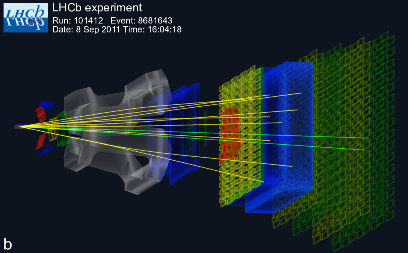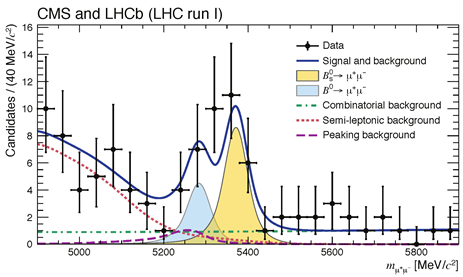Observation of the rare Bs0→μμ decay from the combined analysis of CMS and LHCb data
[ Branching fraction Bs0→μμ = (2.8+0.7-0.6)x10-9 ; B0→μμ = (3.9+1.6-1.4)x10-10 ]
The CMS and LHCb Collaborations have published today in Nature the first observation of the decay Bs0→μμ, with a statistical significance exceeding six standard deviations, and the best measurement of its branching fraction to date. Furthermore, a three standard deviation evidence for the decay B0→μμ is also obtained. Both measurements are statistically compatible with Standard Model (SM) predictions and allow stringent constraints to be placed on theories beyond the SM. This is one of the most important results obtained by the LHC experiments from the run 1 and tests the SM to the ninth decimal place. The excellent performance of the CMS and LHCb detectors and their data analyses was crucial in obtaining this result as well as the outstanding performance of the LHC itself. The two experiments found a total of about 100 Bs0 and B0 decays into two muons in a sample comprising 1012 beauty hadrons collected during 2011 and 2012.
The SM of particle physics describes the fundamental particles and their interactions via the strong, electromagnetic, and weak forces. It provides precise predictions for measurable quantities that can be tested experimentally. The SM predicts that the Bs0→μμ and B0→μμ decays are very rare, with about four of these decays occurring for every billion Bs0 mesons produced and one decay for every 10 billion B0 mesons. Prior to the start of operation of the LHC, no evidence for either decay mode had been found, despite around 30 years of searching at previous experiments. Upper limits on the branching fractions were an order of magnitude above the SM predictions.
The probabilities, or branching fractions, of the Bs0 and B0 mesons to decay into two oppositely charged muons are very small in the SM and are well predicted. On the other hand a large class of theories that extend the SM, like supersymmetry, allows significant modifications to these branching fractions and therefore an observation of any significant deviation from the SM prediction would indicate a discovery of new effects. The Bs0 and B0 meson decays into a muon pair have long been regarded among the most promising class of measurements where these new effects could show up. Previous LHCb results already severely constrained the type of SM-extension models that are still allowed, as described in the 30 March 2012 news. The results announced in today’s publication isolate even more precisely the parameter region in which these new models can exist, and therefore focuses future experimental searches and theoretical attention. All candidate models of physics beyond the Standard Model will have to demonstrate their compatibility with this important result.
The two collaborations first released their individual results for Bs0 meson decay as described in 24 July 2013 news. While the results were in excellent agreement, both fell just below the five sigma statistical precision historically needed to claim an observation. The combined analysis improves the precision of the results and in the same time easily exceeds the 5 sigma requirement, reaching 6.2 sigma. This is the first time that a combined analysis of sets of data from more than one LHC experiment has been performed.
The Bs0 and Bs0 mesons are produced in the pp collision point and decay into a muon pair after a distance of the order of 1cm. The left image shows the Bs0 meson decay into two muons presented as green tracks traversing the whole detector. A few other Bs0→μμ decay images can be found at this web page (1, 2, 3). The right image shows one of the μ+μ– invariant mass spectra released today, in which an excess, attributed to the signal decays, can be clearly seen above the expected background shape.
The LHCb and CMS experiments will resume data taking in June with proton-proton collisions at a centre-of-mass energy of 13 TeV, which will approximately double the production rates for Bs0 and B0 mesons and lead to further improvements in the precision of these crucial measurements.
Read more in the Nature publication, in the CERN Press Release, in the Nature news, in the CERN news in English and French and in the theorist’s comment in CERN Courier.


